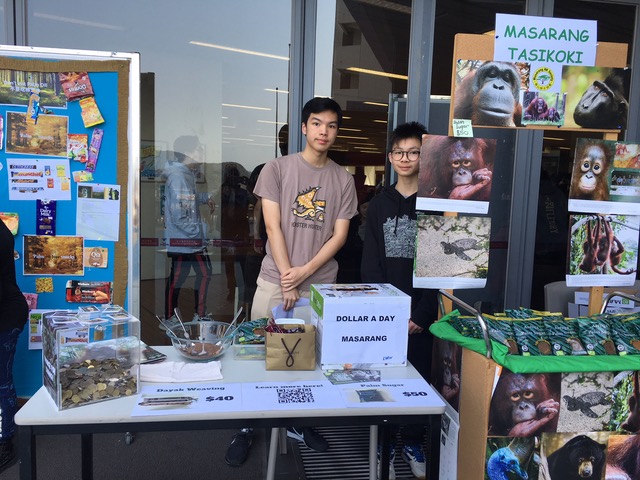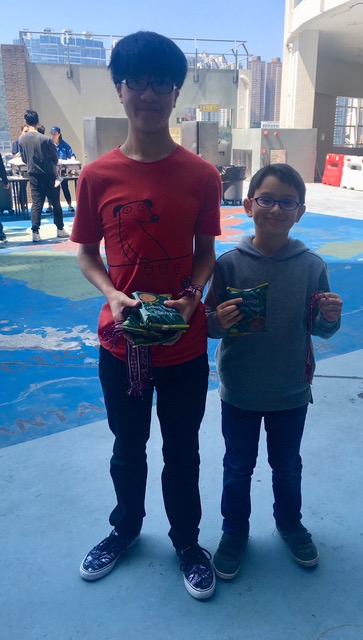The Victoria Shanghai Academy Secondary Tasikoki Team have just returned to Hong Kong from Tasikoki after a CAS trip to Tasikoki in Sulawesi.
The school community, both secondary and primary, has been supporting Masarang HK and Tasikoki, as well as the Sintang Orang-utan Centre charity and the associated projects for many years.
We are all very grateful for their generous and most caring support!
After Adrienne, from Masarang HK, visited the VSA Tasikoki Team twice to gave two talks providing some information about the charity, the aims of the projects and the Tasikoki experience, the students took part in a number of very successful activities to prepare for the trip and also to raise fund to buy much needed wish list items.
Please see the great fund raising during Family Fun Day, with the primary stall and Masarang Club members alongside.
It was lovely to see both the primary and secondary working together to raise funds for the charity!



The group donated a wonderful amount of wish items and all of us at Masarang HK would like to thank the students and teacher leaders for their support and hard work.
Although Mr Patrick McMahon was unable to go to Tasikoki, due to a family emergency, he prepared the students and worked hard with a bracelet sale, along with Ms Karin Samuels, who had most creative ideas about fund raising, especially the amazingly successful ‘Change for Change appeal’. Alice Poon, from 11N, will explain more about that below.
 The VSA Tasikoki Team with all the amazing donations.
The VSA Tasikoki Team with all the amazing donations.
Please read Alice Poon’s pre-visit report below:-
As our trip to Tasikoki is approaching, our students at VSA have been working continually in preparation with excitement. We have been running a ‘Change for Change’ campaign weekly, where students are encouraged to donate their loose change to the Masarang Foundation, most of which would be used to buy items for the foundation’s wish list for things such as food, work equipment, miscellaneous appliances and so on.
The campaign advocates the idea that small actions can contribute to big changes in the community. Although the thought of collecting loose change may not sound like it could achieve a lot, we have actually successfully managed to accumulate full boxes and bags of collections after each session. Many students donated large amounts of their spare change without hesitation when they spotted the collection boxes, but there were a few heartening moments where students and teachers would donate $20, $50 and even $100 dollar bills.
Other than ‘Change for Change’, we also held a booth during our school’s Family Fun Day where we sold items such as bracelets that helps to plant trees through the sums, bookmarks that are multifunctional and made by the local Indonesian women, and palm sugar. It was tremendously motivating to see the support that our peers and their families had for the foundation. Several students came up to the booth as they were interested in the bags of palm sugar, but then became interested in the environmental concerns as well as the work of Masarang and Tasikoki, and began asking questions about volunteering. Not only were we able to raise funds for the organisation, we also helped to inspire and encourage many students to get involved in the future.
We are currently working on organising fundraising events in school to collect more donations and items needed for our trip. We hope that through these events, we are able to promote and establish the importance of the voluntary work of Masarang and Tasikoki in our community.
-Alice Poon 11N
Finally, please read Toby So’s report on the visit below.
CW21- Manado, Indonesia
It would be no surprise for a bug to be crawling on your shoulder when you sleep. We arrived at the Tasikoki resort on the first night under a heavy rain, which lured all the insects into the lodge. Though that did not give us the best first impression of the place, we were soon forced to adapt to this forest environment.
The first days of the trip helped us learn about the geography of Indonesia, and also acknowledge how fortunate we are to live in Hong Kong. Despite the abundant amount of insects, we were toured around the Tasikoki Wildlife Rescue Centre, learning the rules and the week’s schedules, but most importantly understanding our goal to promote sugar palm trees and reduce human pollution.
 The Bitung School introduced us to the culture of Indonesia, welcoming us with their traditional dance and traditional food such as panada. We socialized with the local school students, discussing our school environments and the difference between our cultures. The students were very kind and we were able to communicate fluently in English.
The Bitung School introduced us to the culture of Indonesia, welcoming us with their traditional dance and traditional food such as panada. We socialized with the local school students, discussing our school environments and the difference between our cultures. The students were very kind and we were able to communicate fluently in English.
At the Tasikoki Beach and the Tulap Beach, we picked up the trash trapped in the beach. After cleaning up the trashes which are hidden in the sands, we would just wait at the shoreline of the beach and wait for the rubbish to come to us. It was surprising to see that the rubbish would naturally come to us, as we wait for the waves to push the rubbish to the shoreline.
Moreover, we planted sugar palm trees and pineapple trees around the resort of Tasikoki. We used a trowel to dig a hole for the plant to be placed in, we then had to straighten or position the plant appropriately, and use the trowel to fill the rest of the hole with soil, so that the roots of the plant are covered and protected.
The intense sunlight with the cooling water was an excellent combination to provide us with an enjoyable snorkeling experience at the Lembeh Strait. Roaming through the strait on top of a speedboat was probably the most relaxing moment of the entire trip, despite not being able to hear a thing with the wind constantly blowing against the ear. We often saw jellyfishes near the surface of the water, but we had to stay away from them to avoid getting stung. I was very fortunate to find a Moorish Idol, which was a fish species featured in Finding Nemo. The guide of the snorkeling trip helped us locate the unique animals and the camouflaging plants of the sea. The view of the colorful seabed was very gorgeous, but we could sometimes spot plastic either floating on the surface or laying on the corals. At the end of the day, the snorkeling trip reminded everyone of the importance of sunscreen.
 Visiting a third world country might not be the most appealing option when selecting your 2018 CAS trip, and it is definitely not the most enjoyable. Yet, were the other trips able witness the baby turtles hatching, and be given the opportunity to lead them into the ocean? Definitely not. The red light of our torches signalled the baby sea turtles on where they should go. Although only 50% of all baby sea turtles successfully find the sea, and only 0.2% grow up to the next generation, our contribution in the sea turtle project helped eliminate most obstacles the baby turtles experience dashing to the sea. However, due to the lack of time, we were only able to lead 1 baby turtle into the ocean out of the 118 baby turtle eggs, and it was the most relieving feeling to see the baby turtle swim off to his destination.
Visiting a third world country might not be the most appealing option when selecting your 2018 CAS trip, and it is definitely not the most enjoyable. Yet, were the other trips able witness the baby turtles hatching, and be given the opportunity to lead them into the ocean? Definitely not. The red light of our torches signalled the baby sea turtles on where they should go. Although only 50% of all baby sea turtles successfully find the sea, and only 0.2% grow up to the next generation, our contribution in the sea turtle project helped eliminate most obstacles the baby turtles experience dashing to the sea. However, due to the lack of time, we were only able to lead 1 baby turtle into the ocean out of the 118 baby turtle eggs, and it was the most relieving feeling to see the baby turtle swim off to his destination.

A long-term volunteer Gavin compared us with the wild animals through an unforgettable metaphor- “Having an animal trapped in a cage is like locking you in an empty room; without your phone, PS4, nothing. You would probably kill yourself in 5 minutes.” I thought that this metaphor was very convincing as we were able to relate our lives to the lives of the wild animals.
Our walk to the top of Mount Mahawu was less exhausting than expected. We then walked our way around the edge of the volcano crater, which was occupied by plants and tall grasses. There were spots where the plants were cleared so that we could take photos and admire the inside of the dormant volcano. With our eyes staring at the cleared crater of the dormant volcano, our tour guide William told us that prisoners and slaves used to find their way to the bottom of the volcano to farm sulfur, which made gunpowder for the Indonesians
 If we are to continue with our human pollution over the following years, these sugar palm trees might be the only solution to possibly revert our damage and revive the environment.
If we are to continue with our human pollution over the following years, these sugar palm trees might be the only solution to possibly revert our damage and revive the environment.
– Y10C Toby So
Very grateful thanks to the VSA for all the much appreciated support!
Adrienne
Masarang HK
Leave a Reply